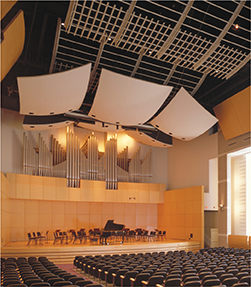Music
Musical instruments can produce a wide variety of sounds. In a wind instrument, such as a flute or trumpet, holes are closed using fingers or valves. This changes the length of the column of air in which a standing sound wave is produced. For some stringed instruments, such as a violin, musicians change the length of the strings by pressing down with their fingers. For other instruments, such as a piano, they use a fixed set of strings of different lengths.  Most musical instruments vary pitch by changing the frequency of standing waves.
Most musical instruments vary pitch by changing the frequency of standing waves.
Musical instruments often use resonance to amplify sound. Resonance (REZ uh nuhns) is the response of a standing wave to another wave of the same frequency. Think of a child being pushed on a swing. If the pushes are timed at the right frequency, the child can swing higher and higher. In the same way, one wave can “push” another wave to a higher amplitude. Resonance can produce a dramatic increase in amplitude. A piano, for example, amplifies sound with a soundboard. The soundboard resonates in response to the vibrating strings.
Once sound waves leave an instrument, they can take several routes to a listener. In a large concert hall, interference with reflected sound waves can be a problem. Theaters such as the one in Figure 20 are designed with reflecting panels and sound-absorbing tiles. These are located with great care to prevent “dead spots” where the volume is reduced by destructive interference of reflected sound waves.
Figure 20 The Central Michigan University Music Building, like many concert halls, was designed by acoustic engineers. Sound-absorbing tiles (on the sides and rear) reduce unwanted reflections. The curved reflecting panels above the stage help gather and direct sound waves toward the audience.

Section 17.4 Assessment
Reviewing Concepts
 List five properties used to explain the behavior of sound waves.
List five properties used to explain the behavior of sound waves. Name two uses for ultrasound.
Name two uses for ultrasound. What is the Doppler effect?
What is the Doppler effect? What are the ear's three main regions? Describe the function of each region.
What are the ear's three main regions? Describe the function of each region. How is sound recorded?
How is sound recorded? How does a musical instrument produce notes at different pitches?
How does a musical instrument produce notes at different pitches?
Critical Thinking
Applying Concepts If workers in a distant stone quarry are blasting, why can you feel the explosion in your feet before you hear it?
Comparing and Contrasting How does the intensity of a 40-decibel sound compare to the intensity of a 20-decibel sound?
Applying Concepts How could a bat use reflections of sound waves to determine distance to an insect?
Connecting Concepts
Frames of Reference Review what you learned about combining velocities in Section 11.2. Then explain why the Doppler effect depends on the velocity of the sound source in the observer's frame of reference.




